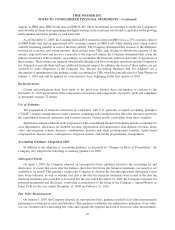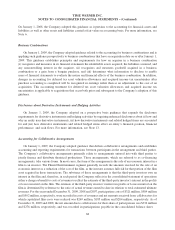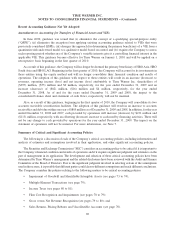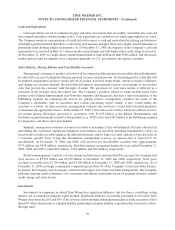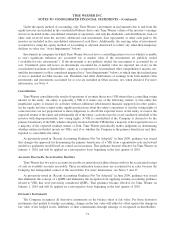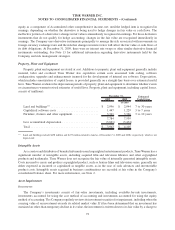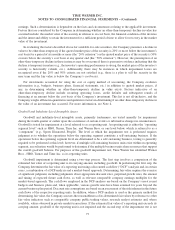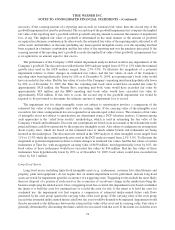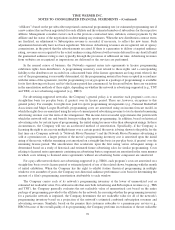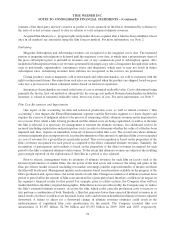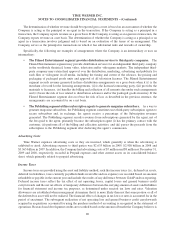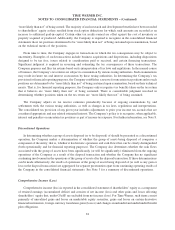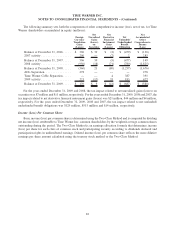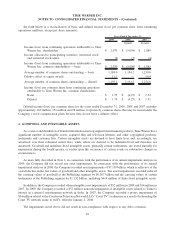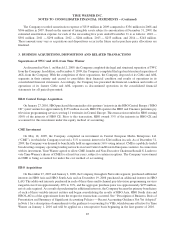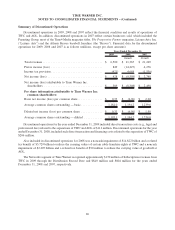Time Magazine 2009 Annual Report Download - page 89
Download and view the complete annual report
Please find page 89 of the 2009 Time Magazine annual report below. You can navigate through the pages in the report by either clicking on the pages listed below, or by using the keyword search tool below to find specific information within the annual report.value of unamortized programming costs based on the package of programming provided to the subscribers by the
network. Specifically, the Company determines the net realizable value for all of its premium pay service
programming arrangements based on projections of estimated Subscription revenues and, where applicable,
home video and other licensing revenues. In addition, changes in management’s intended usage of a program,
such as a decision to no longer air a particular program and forego the rights associated with the program license,
would result in a reassessment of that program’s net realizable value, which could result in an impairment.
Filmed Entertainment
Feature films typically are produced or acquired for initial exhibition in theaters, followed by distribution in the
home video, video-on-demand, pay cable, basic cable and broadcast network markets. Generally, distribution to the
home video, pay cable, basic cable and broadcast network markets each commence within three years of initial
theatrical release. Theatrical revenues are recognized as the films are exhibited. Revenues from home video sales
are recognized at the later of the delivery date or the date that video units are made widely available for sale or rental
by retailers based on gross sales less a provision for estimated returns. Revenues from the distribution of theatrical
product to television markets are recognized when the films are available to telecast.
Television films and series are initially produced for broadcast networks, cable networks or first-run television
syndication and may be subsequently licensed to foreign or domestic cable and syndicated television markets, as
well as sold on home video. Revenues from the distribution of television product are recognized when the films or
series are available to telecast, except for barter agreements where the revenue is valued and recognized when the
related advertisements are exhibited. Similar to theatrical home video sales, revenue from home video sales of
television films and series is recognized at the later of the delivery date or the date that video units are made widely
available for sale or rental by retailers less a provision for estimated returns.
Upfront or guaranteed payments for the licensing of intellectual property are recognized as revenue when (i) an
arrangement has been signed with a customer, (ii) the customer’s right to use or otherwise exploit the intellectual
property has commenced and there is no requirement for significant continued performance by the Company,
(iii) licensing fees are either fixed or determinable and (iv) collectability of the fees is reasonably assured. In the
event any significant continued performance is required in these arrangements, revenue is recognized when the
related services are performed.
Film costs include the unamortized cost of completed theatrical films and television episodes, theatrical films
and television series in production and film rights in preparation of development. Film costs are stated at the lower
of cost, less accumulated amortization, or fair value. The amount of capitalized film costs recognized as cost of
revenues for a given film as it is exhibited in various markets, throughout its life cycle, is determined using the film
forecast method. Under this method, the amortization of capitalized costs and the accrual of participations and
residuals is based on the proportion of the film’s revenues recognized for such period to the film’s estimated
remaining ultimate revenues. The process of estimating a film’s ultimate revenues (i.e., the total revenue to be
received throughout a film’s life cycle) is discussed further under “Film Cost Recognition and Impairments.”
Inventories of theatrical and television product consist primarily of DVDs and are stated at the lower of cost or
net realizable value. Cost is determined using the average cost method. Returned goods included in inventory are
valued at estimated realizable value, but not in excess of cost. For more information, see Note 5.
The Company enters into arrangements with third parties to jointly finance and distribute many of its theatrical
productions. These arrangements, which are referred to as co-financing arrangements, take various forms. In most
cases, the form of the arrangement is the sale of an economic interest in a film to an investor. The Filmed
Entertainment segment generally records the amounts received for the sale of an economic interest as a reduction of
the cost of the film, as the investor assumes full risk for that portion of the film asset acquired in these transactions.
The substance of these arrangements is that the third-party investors own an interest in the film and, therefore, in
each period the Company reflects in the consolidated statement of operations either a charge or benefit to costs of
revenues to reflect the estimate of the third-party investor’s interest in the profits or losses incurred on the film. The
77
TIME WARNER INC.
NOTES TO CONSOLIDATED FINANCIAL STATEMENTS – (Continued)


